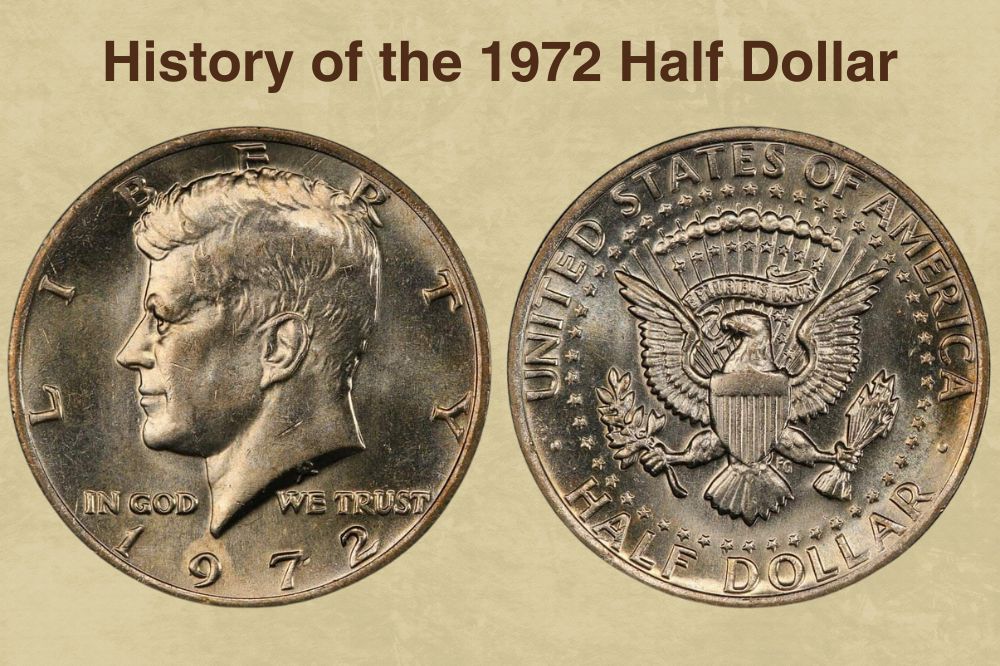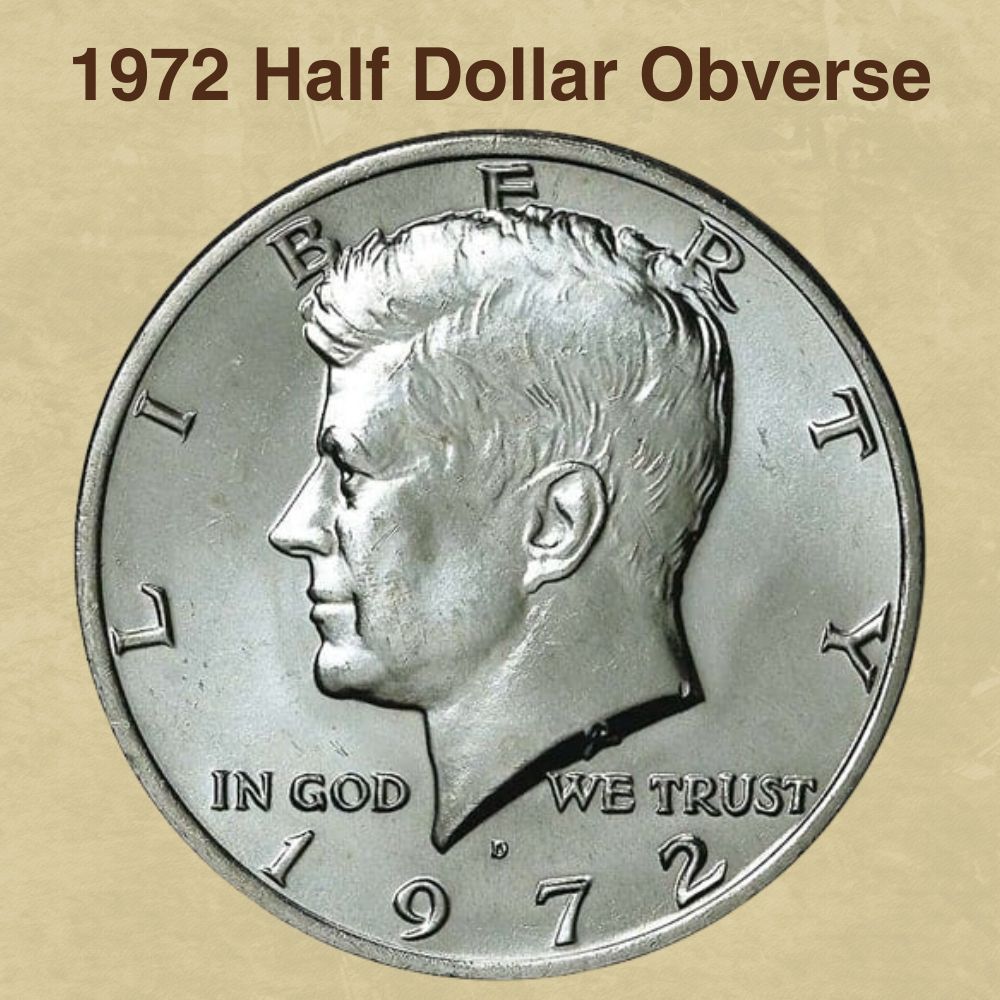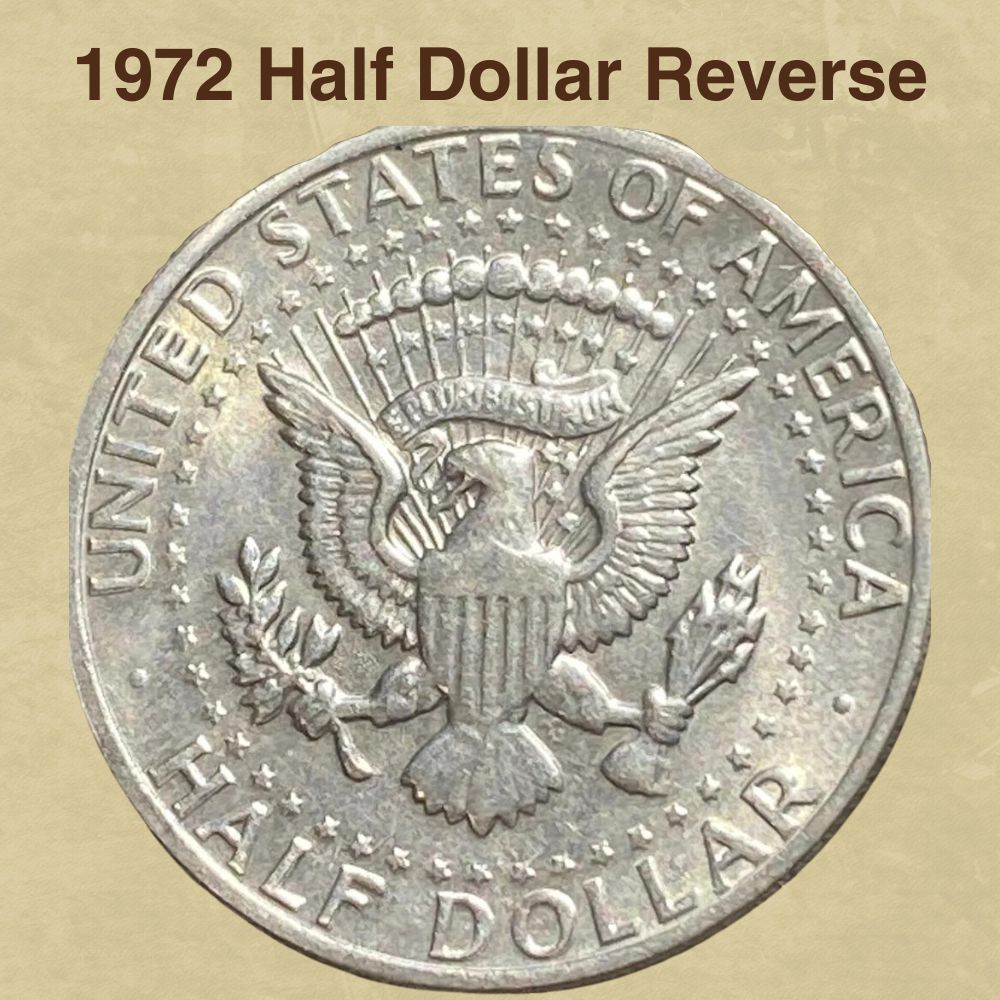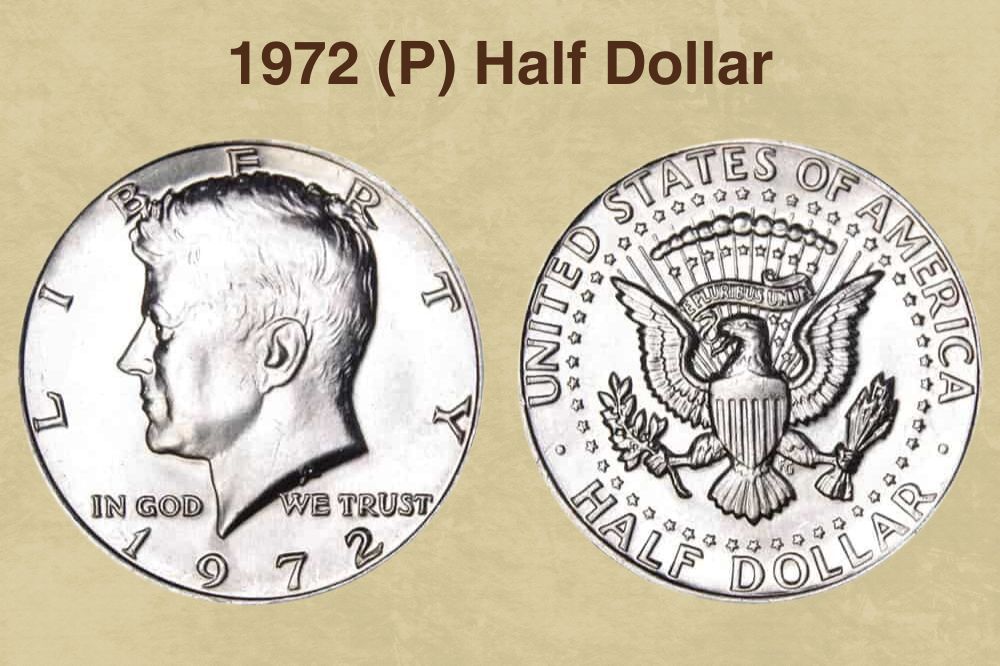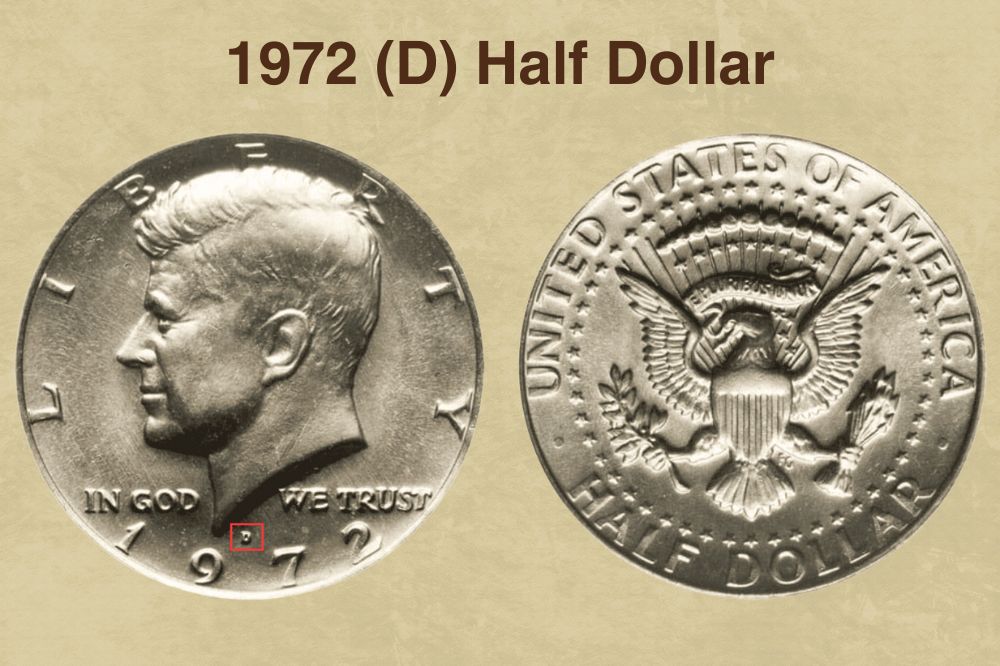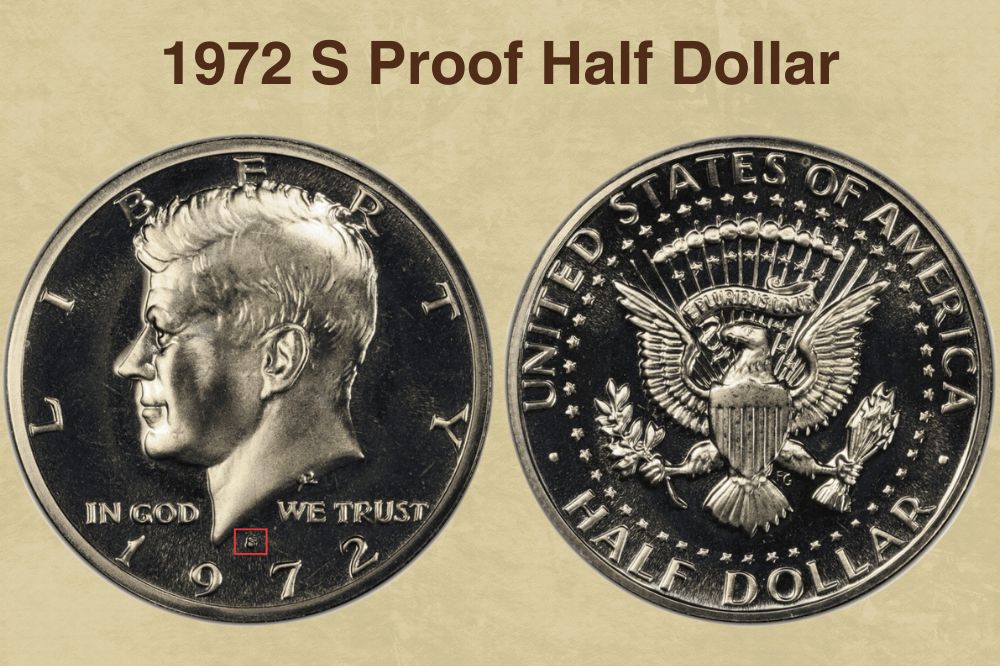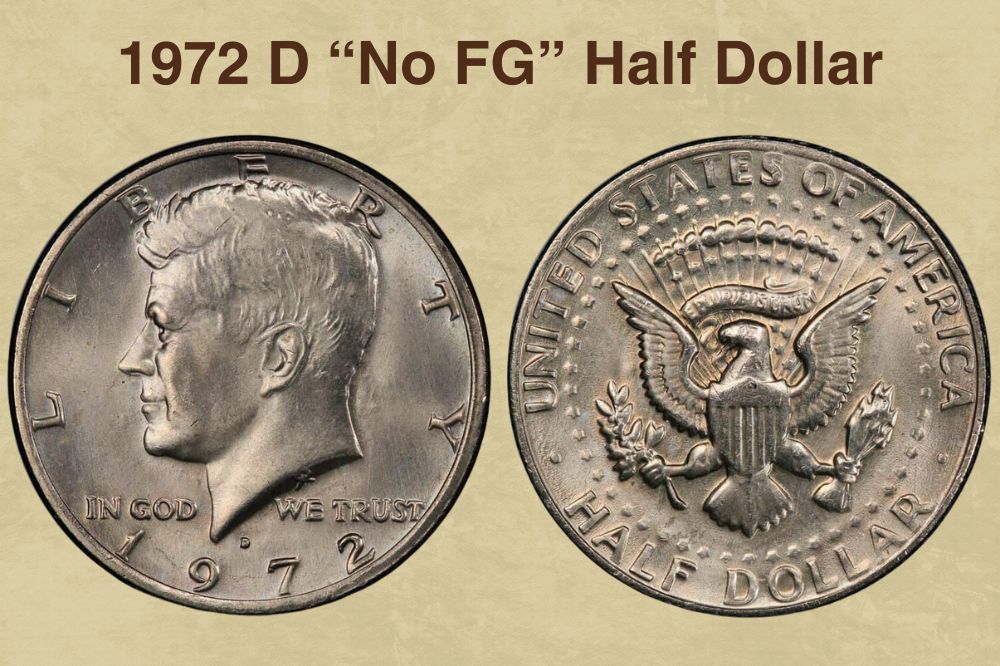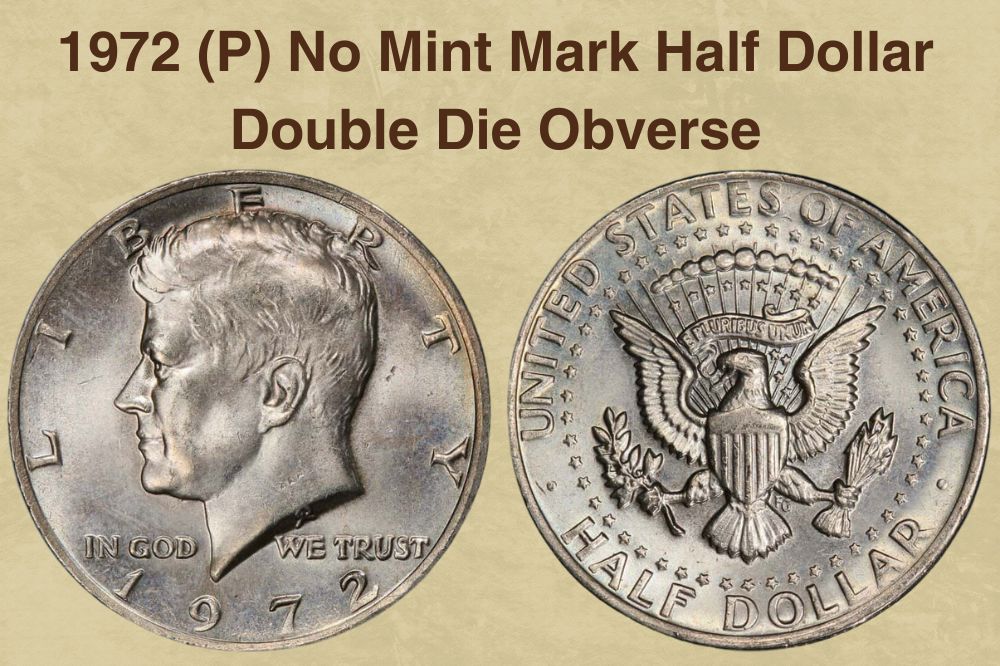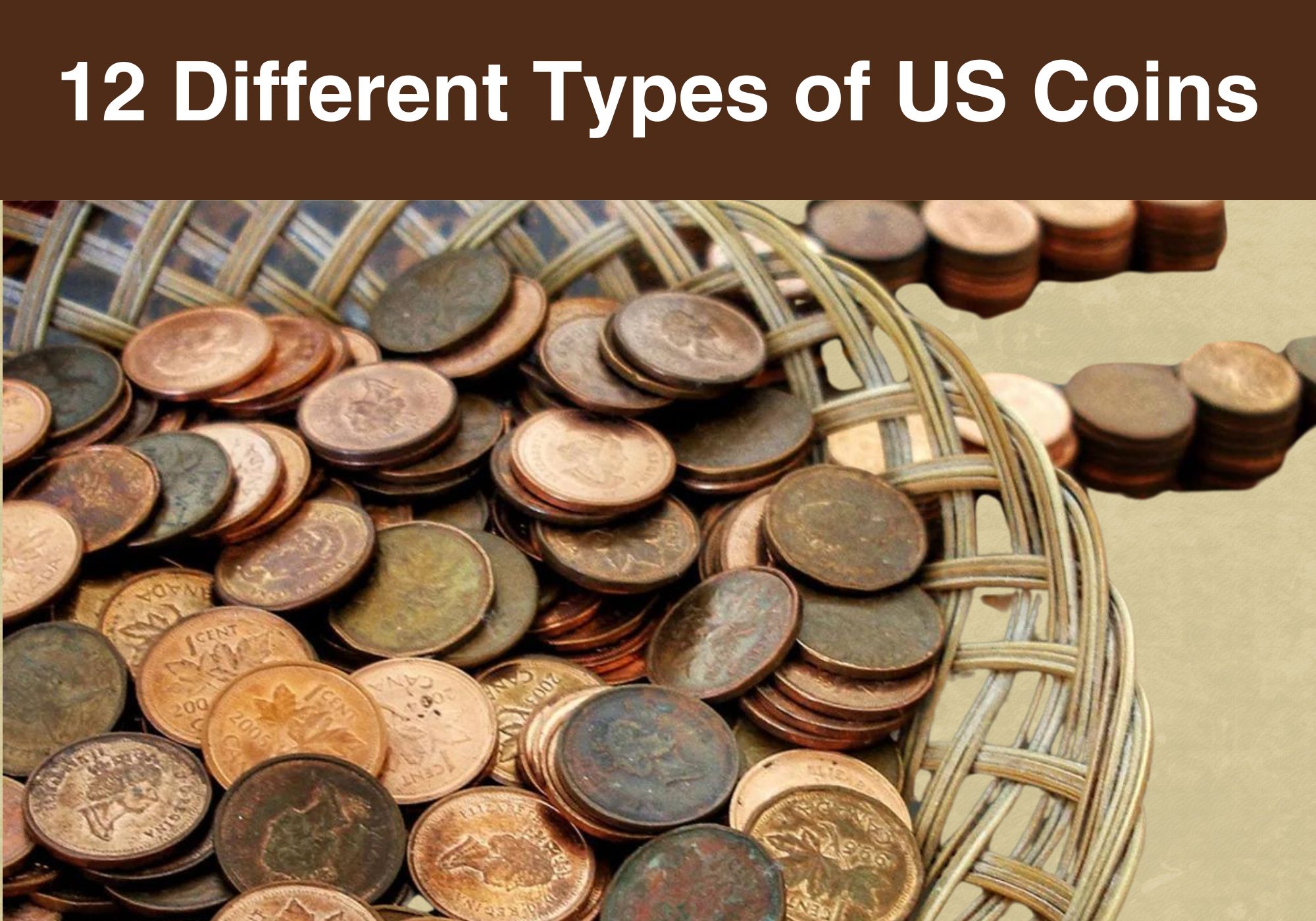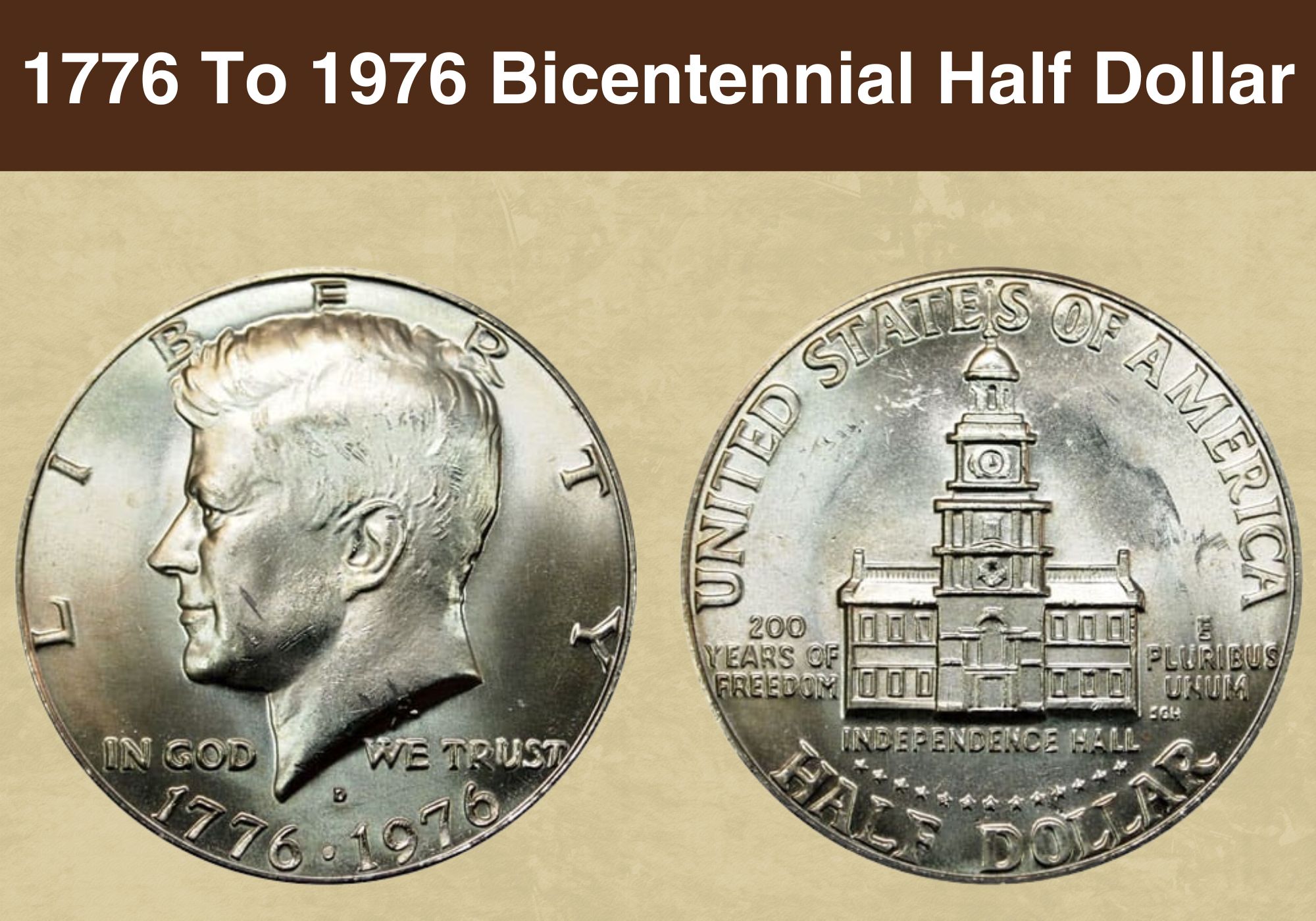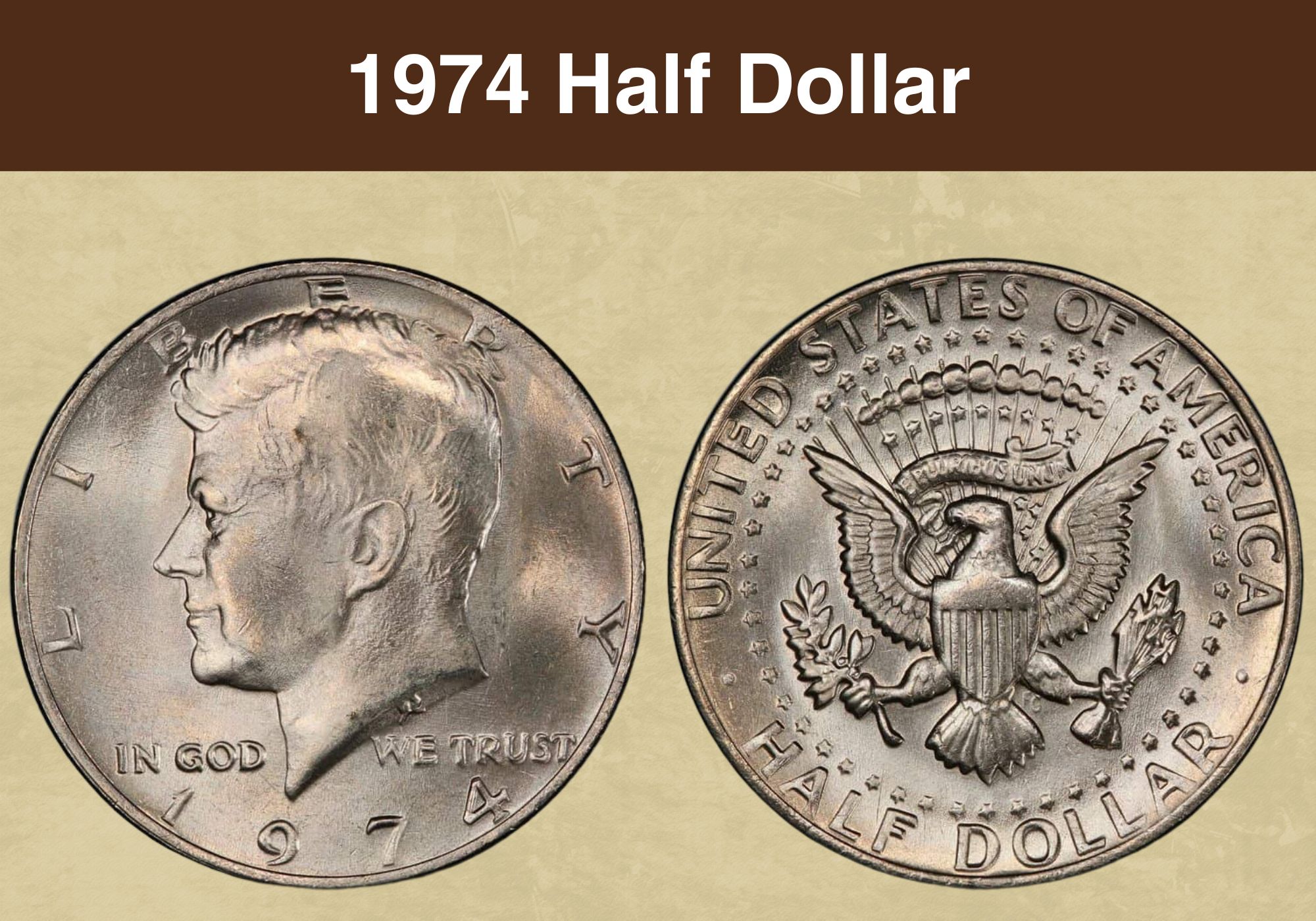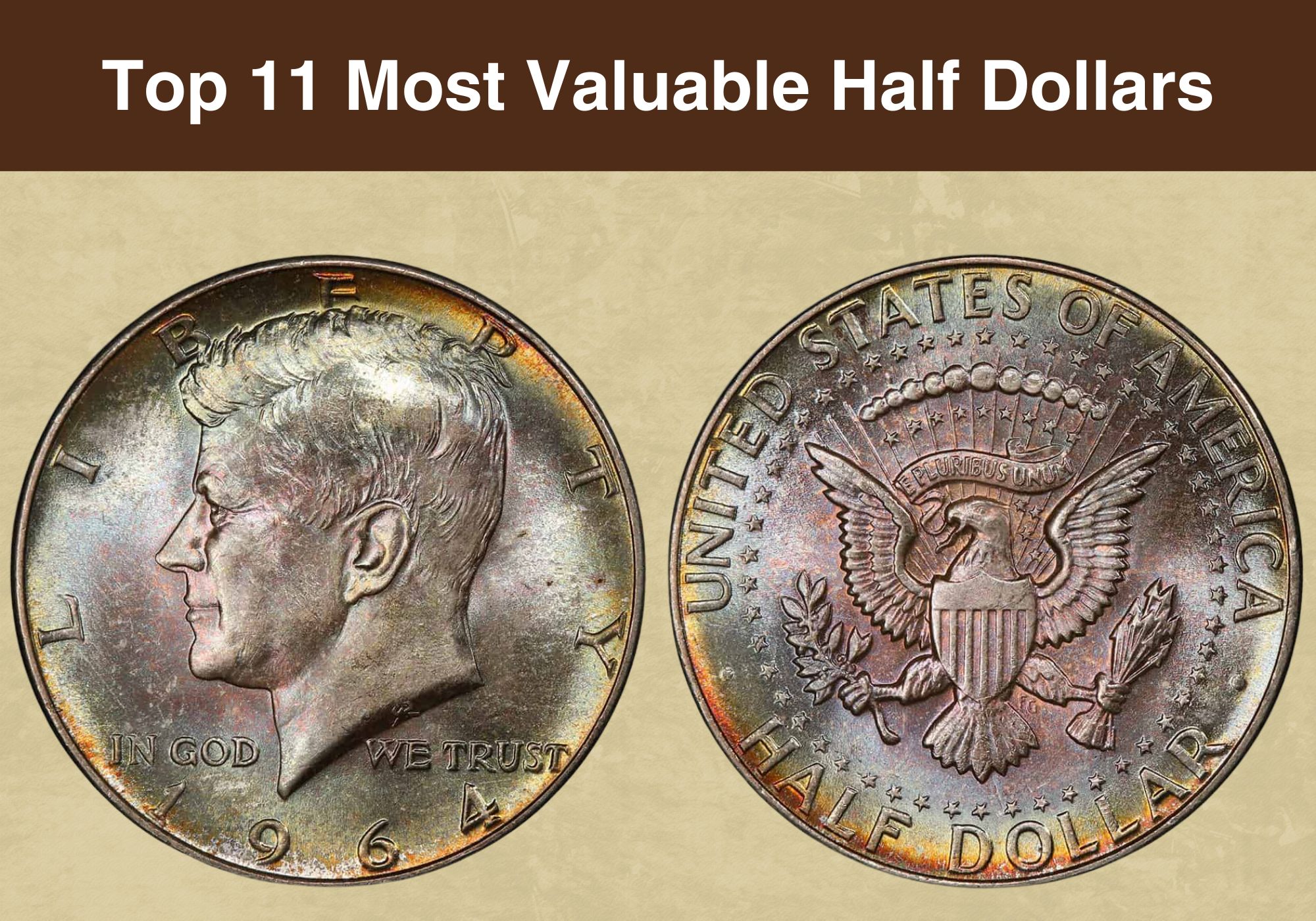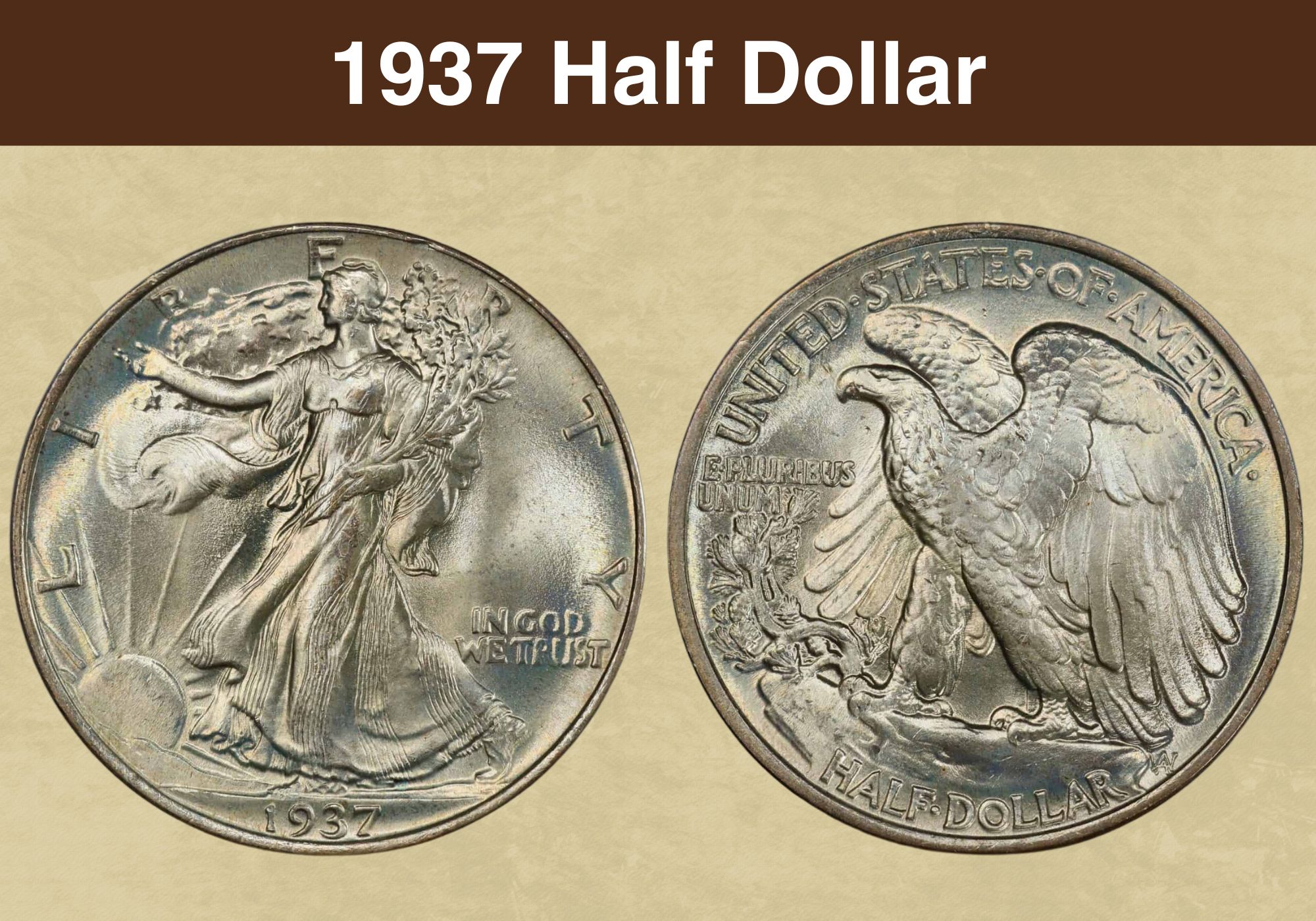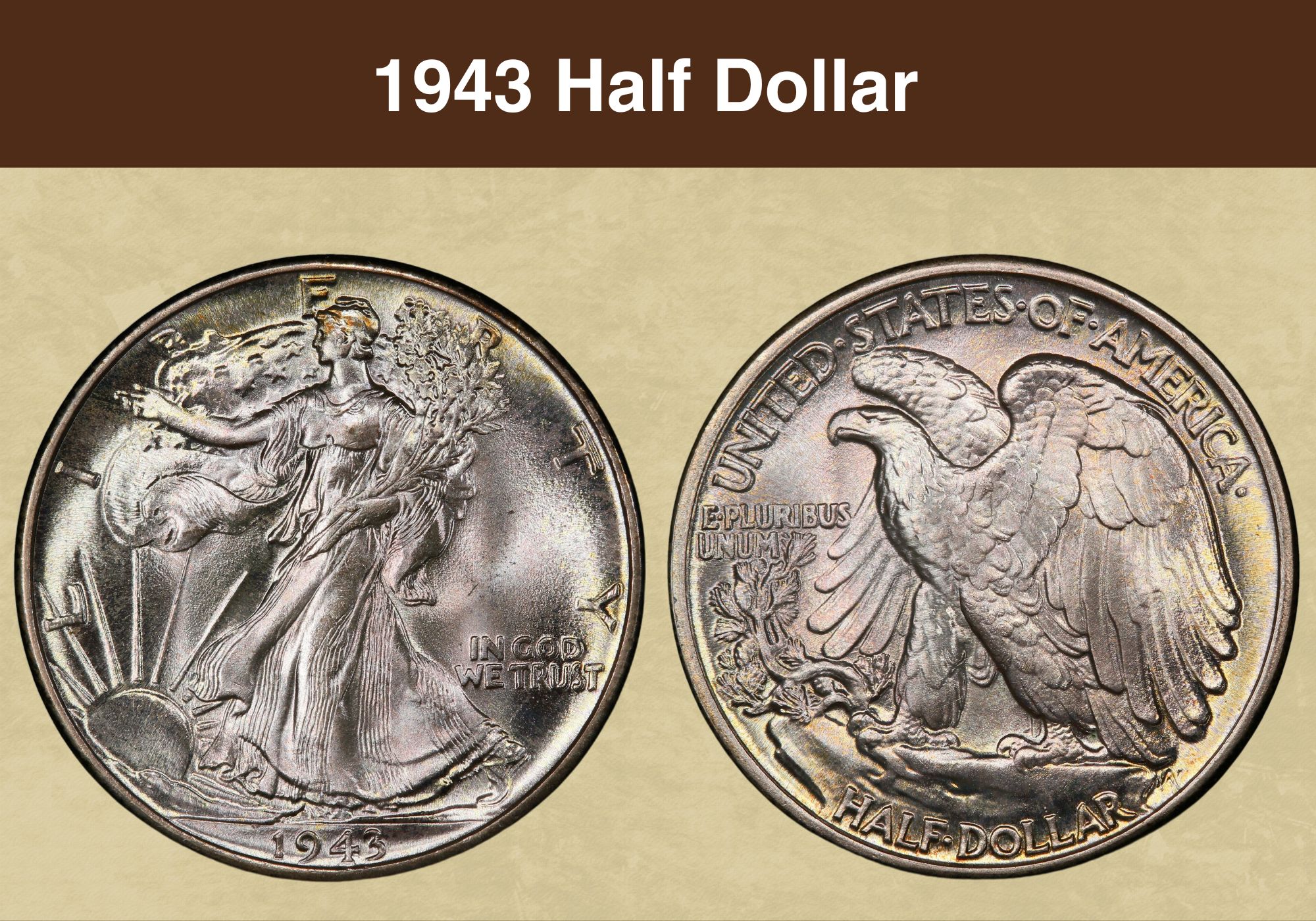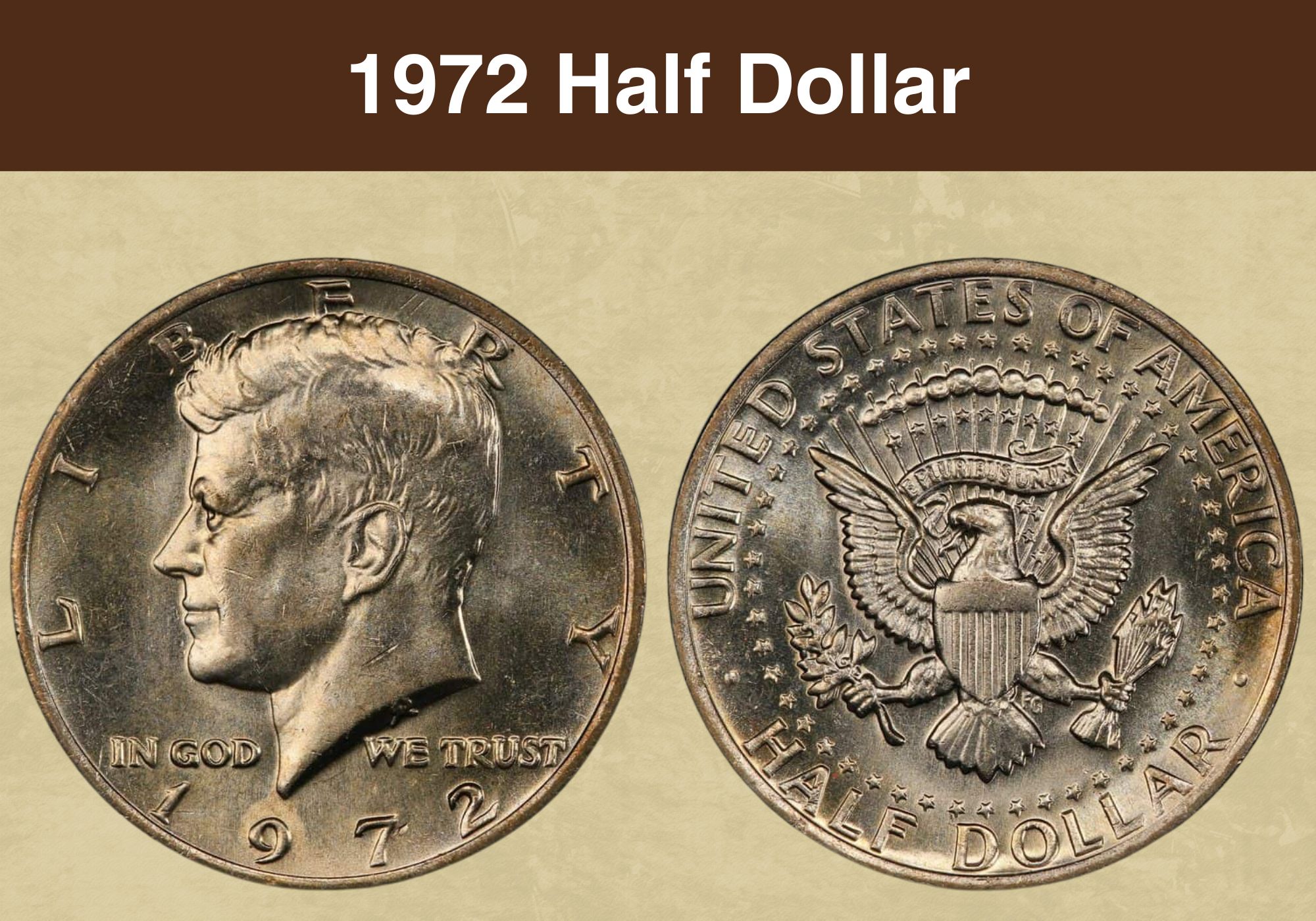
Coin Value Contents Table
The half dollar coins minted in 1972 are known as Kennedy half dollars. And if you’re interested in finding out more about them, you’ve come to the right place.
We’re going to explore the 1972 half dollar value, and the factors that influence how much an individual coin is worth. We’ll investigate the history and design of the series. And we’ll take a look at some of the interesting error coins that are out there, and how they came to be made.
So if you’re ready to find out more, step this way!
1972 Half Dollar Value Chart |
||||
| Mintmark and Variety | XF45 | MS60 | MS65 | MS67 |
| 1972 (P) No Mint Mark Half Dollar Value
|
$1 | $4 | $25 | $1,600 |
| 1972 D Half Dollar Value | $1 | $5 | $20 | $150 |
|
|
PR60 | PR65 | PR67 | PR69 |
| 1972 S Proof Half Dollar Value | $4
Cameo: $5 Deep cameo: $6 |
$7
Cameo: $8 Deep cameo: $9 |
$9
Cameo: $10 Deep cameo: $11 |
$14
Cameo: $24 Deep cameo: $65 |
History of the 1972 Half Dollar
The history of the half dollar coin stretches all the way back to the eighteenth century. The first ever examples were produced in 1795.
Many different varieties of half dollar coins were struck over the years. But those produced in 1972 are part of the series known as Kennedy half dollars.
They take their name from the image of the former president that appears on their obverse (the “heads” side). They were first struck in 1964 to honor John F. Kennedy.
Other Presidential coins were issued to mark the anniversaries of the respective president’s birth. Kennedy dollars, however, were a memorial to a president who had been assassinated – a crime that shocked the world.
Just a month after that terrible event, Congress authorized the new coins. The Mint engravers Frank Gasparro and Gilroy Roberts had already produced designs, so it was possible for production to start quickly. The first half dollars were struck just two months after Kennedy’s death.
The choice of the half dollar as the denomination to honor Kennedy had been his wife Jacqueline’s. The other options presented to her were the quarter and the dollar. But she felt her late husband would not have wanted to displace the image of Washington.
The earliest Kennedy half dollars were struck in silver. But silver prices were rising – and that, together with the historic nature of the coins, and the emotional response of the public, meant that almost all of them were hoarded.
The rising silver price was a problem for other denominations too. Dimes and quarters were also being removed from circulation. People thought their silver content might soon be worth more than their face value.
In 1965, Congress responded by eliminating silver from dimes and quarters. And the silver content of Kennedy half dollars was reduced from 90 to 40 per cent. That remained the position until 1970, when silver was removed from the half dollar too.
The coins struck in 1972 were still silver in color. But the shade resulted from a cladding of copper and nickel.
But by then, people had become used to collecting half dollar coins, rather than spending them. The new composition did increase circulation slightly, but the coins remained unpopular for day-to-day use.
As a result, the Mint found itself with large numbers of half dollar coins held in reserve. And while the denomination continues to be struck in small numbers to this day, since 2002, the coins have been aimed at collectors.
Also read: 13 Most Valuable Franklin Half Dollars Worth Money
Features of the 1972 Half Dollar
The Obverse of the 1972 Half Dollar
At the heart of the design of the 1972 dollar is the portrait of John F. Kennedy which appears on the obverse. It shows the late President in profile facing left.
Speed was of the essence in preparing the coin, so the portrait was based on an existing image. The Mint engraver, Gilroy Roberts, had created the image for use in a series of presidential medals.
Roberts had met the President to gain his approval for early drafts of the portrait. And Kennedy had approved the final image.
The new version prepared for the half dollar was very similar. The only difference was the President’s enigmatic smile; he had worn a more neutral expression in the original portrait.
Jacqueline and Robert Kennedy were invited to view trial strikes of the coin. The former First Lady apparently suggested a small change to the engraving of the hair in the portrait.
Kennedy’s image takes up most of the obverse of the coin. The word “LIBERTY curves along the top edge, while Roberts’ initials are inscribed discreetly on the cut-off at the bottom.
“IN GOD” is inscribed to the left of Kennedy’s neck and “WE TRUST” is to the right as the coin is viewed. The date is also inscribed on the obverse, curving along the lower edge.
The Reverse of the 1972 Half Dollar
The image on the reverse was the work of Frank Gasparro, then Assistant Engraver at the Mint. Gasparro succeeded Gilroy Roberts as Chief Engraver a month after the Kennedy half dollar was launched.
Like the obverse image, the time constraints necessitated the use of a pre-existing design. This too had originally been used in Kennedy’s Presidential Series medal.
It shows the President’s Seal, an eagle, and a shield. The eagle clutches an olive branch in one set of talons, while in the other is a fletch of arrows. Stars circle the image, representing the US states. And if you look closely below the eagle’s leg, most coins have the initials “FG” for Frank Gasparro.
The Latin motto “E PLURIBUS UNUM”, meaning “From the many, one”, is inscribed above the eagle. The country name is at the top of the coin, while the denomination – written in full as “HALF DOLLAR” – is at the bottom.
Other Features of the 1972 Half Dollar
Business strikes of the 1972 Kennedy half dollar – i.e. coins intended for general circulation – were produced in both Philadelphia and Denver. Proof coins, those made with special planchets and dies, were struck only in San Francisco.
The first mint marks didn’t appear on coins struck in Philadelphia until 1979. But the 1972 half dollars struck in San Francisco are marked with an “S” and those in Denver with a “D”. Find the mint marks on the obverse, above and between the “9” and “7” of the date.
Each half dollar measures 30.61 millimeters across and weighs 11.3 grams. That’s 1.2 grams lighter than the Kennedy dollars made from 90 per cent silver, and 0.2 grams lighter than those made of 40 per cent silver.
The edge is decorated with 150 “reeds”. Those are vertical grooves which run perpendicular to the coin faces. Centuries earlier, they were used as anti-fraud devices to identify coins with clipped edges. But by 1972 they were largely decorative.
This YouTube video from DC Coin World explores the Kennedy half dollar through history.
Also read: 13 Most Valuable Kennedy Half Dollar Worth Money
1972 Half Dollar Value Guides
1972 (P) Half Dollar Value
Over 153 million half dollars were struck at the Philadelphia Mint facility in 1972. That slightly more than the number that came out of Denver, and far more than the proofs from San Francisco.
It was one of the largest mintages of the whole series of Kennedy half dollars. And today, the independent coin grading agency, the PCGS, estimates that well over 30 million coins survive at all grades.
Mint state examples – coins that have never been circulated – aren’t in short supply either. There are thought to be over 3 million of those still in existence. And “gem quality” coins – those graded 65 or above – are thought to number more than 600,000.
All this means that it’s possible to find a coin in great condition without having to spend large sums of money.
An example graded XF45 (the “XF” stands for “extremely fine”) can be bought for around a dollar. And even mint state coins start at just $4.
If you want a gem coin, you’ll have to part with folding money. The PCGS values a half dollar graded MS65 at $25.
At MS66+, values reach three figures, and they rise rapidly from there. The PCGS has certified just 25 coins at MS67, and values those at $1,600 apiece.
Just one coin has been given a higher grade. The sole MS67+ 1972 Philadelphia half dollar is worth around $5,000.
1972 (D) Half Dollar Value
The Denver Mint facility was only just behind Philadelphia in the number of 1972 half dollars it struck. That year, it churned out almost 142 million of them.
They can be identified by the small “D” which appears just below Kennedy’s neck. And at lower grades, the values are very similar to the Philadelphia examples.
An extremely fine example graded XF45 will set you back around a dollar. That rises to $5 for an MS60 example, and $20 for an MS65 gem.
Values jump from $40 at MS66+ to $150 at MS67. And the finest examples known to exist are four coins graded MS67+. The PCGS values those at a princely $2,000 a pop.
1972 S Proof Half Dollar Value
The San Francisco Mint facility specializes in producing high quality coins. So it was the natural choice to mint more than 3.26 million proof half dollars in 1972.
These coins were struck using specially prepared dies on highly polished planchets. They were designed to be collected, rather than used. And as a result, most have survived in excellent condition.
This means that values are lower than you might expect. And it’s possible to obtain a premium coin for an everyday price.
Proof coins are graded with the prefix PR. A 1972 proof silver half dollar graded PR60 is worth only $4 or so. Values rise gradually from there, to $9 at PR65 and $14 at PR67.
The highest graded specimens out there are a near-perfect PR69 – but they are so plentiful that they’re still inexpensive. The PCGS has certified well over 800 half dollars at that level, and there are probably plenty more to be found. They’re each valued at just $14.
Coins classified as cameos or deep cameos – those with an attractive contrast between glossy fields and frosted designs – attract a small premium. But the most valuable PR69 deep cameo is still worth only around $65.
Also read: 11 Most Valuable Half Dollars In Circulation
1972 Half Dollar grading
Rare 1972 Half Dollar Error List
1972 D “No FG” Half Dollar
Amongst the half dollars struck in 1972 are a small proportion that don’t have the artist’s initials. The “FG” for Frank Gasparro should appear on the reverse, between the eagle’s tail feathers and leg (the leg on the right, as the coin is viewed). But somehow, they are missing in a few coins.
Some people think this is a result of an error during the manufacture of the die used to strike the reverse. It’s more likely, however that the die started life with the initials intact. They were then removed as an unintended consequence of polishing the die to remove clash marks.
While almost 142 million half dollars were struck at Denver in 1972, those without the “FG” are very rare. The PCGS gives them the variety code FS-901. And they’re valuable in any condition.
An example graded a lowly 20 is worth around $60, while you’ll need to pay over three figures for anything graded 30 and above.
An extremely fine coin graded XF45 is valued by the PCGS at $250, while mint state examples start at $450.
Only a handful of coins have been certified at MS64 and above. The finest known example is a sole coin graded MS66, which is valued by the PCGS at $4,500.
1972 (P) No Mint Mark Half Dollar, Double Die Obverse
Sometimes errors are made during die manufacture. Tthose errors are then transferred to the coins struck by the die.
Double die errors occur as the die is struck by the hub to capture the design. It has to be struck more than once. And if there’s any movement between the two strikes, a double image will result.
If that happens to the die used to strike the obverse, the resulting coin is a “double die obverse” or DDO. And there are a number of DDO errors amongst the 1972 Philadelphia half dollars.
You may need a coin microscope or loupe to spot the doubling. Look for it on the letters of “IN GOD WE TRUST”.
A 1972 half dollar with this error and graded XF45 is worth around $40. The PCGS values a mint state example at $100 at MS60, rising to $850 for the finest known grade, MS65.
Check out this YouTube video from Couch Collectibles for a range of 1972 half dollar error coins and other rare examples.
Where to Sell Your 1972 Half Dollar ?
Now that you know the value of your coins, do you know where to sell those coins online easily? Don’t worry, I’ve compiled a list of these sites, including their introduction, pros, and cons.
Check out now: Best Places To Sell Coins Online (Pros & Cons)
FAQs
What makes a 1972 half dollar rare?
Most 1972 half dollars aren’t rare. But the exceptions are coins in very high grades, those with interesting errors – or both.
One of the rarest varieties is the half dollar that doesn’t have the initials “FG” on the reverse. Look carefully at the area between the eagle’s tail feathers and the leg on the right as you view the coin. If there are no initials, you could be holding a very valuable coin.
How can I tell if my 1972 half dollar is silver?
The Kennedy half dollars struck between 1963 and 1970 contained silver. But while those dated 1972 are silver in color, that color comes from nickel. They don’t actually contain any silver at all.

